Team:EPF Lausanne/Project malaria
From 2010.igem.org
(→Malaria) |
(→The malaria cycle in human) |
||
| (19 intermediate revisions not shown) | |||
| Line 19: | Line 19: | ||
= Malaria = | = Malaria = | ||
| - | |||
[[Image:Malaria.png|right|150px|caption]] | [[Image:Malaria.png|right|150px|caption]] | ||
| + | Malaria is a parasitic disease that kills more than 1 million people in tropical and subtropical countries every year. The disease is transmitted when a mosquito takes its bloodmeal from a human infected with malaria. The parasite infects the mosquito, develops inside of it and finally is transmitted to the next person the mosquito bites. | ||
| + | The EPFL iGEM team decided to try to act on the mosquito stage, by preventing the ookinete to cross the midgut epithelium and transform into an oocyst. | ||
[[Image:Malaria cycle.png|left|300px|caption]] | [[Image:Malaria cycle.png|left|300px|caption]] | ||
| Line 30: | Line 31: | ||
| + | ===The malaria cycle in human === | ||
| + | The infection starts when a mosquito takes its bloodmeal and releases the sporozoites that developed in its salivary glands into the human. The sporozoites travel in the human blood stream until they reach the liver. At that point, they invade the hepatic cells and turn into ''merozoites''. The merozoites multiply until they break the liver cell and return to the blood stream where they infect red blood cells. At this stage they develop following an asexual cycle and remain in the blood stream. The parasite is then hidden from the immune system. Some merozoites differentiate into gametocytes, and these are the cells that are waiting for the next mosquito to take his bloodmeal... | ||
| + | [[Image:Mousquito_and_asaia_4.png|right|150px|caption]] | ||
| + | [[Image:Gut2.png|left|300px|caption]] | ||
| + | ===The malaria cycle in the mosquito=== | ||
| - | + | When the mosquito bites a human infected with malaria, it takes up the parasite that is present in the blood. The merozoites cannot resist the digestion process. However, gametocytes have special protection allowing them not to be digested. They then differentiate into male and female gametes. These gametes fuse and differentiate into an ookinete that is able to migrate through the midgut's epithelium. There, it differentiates further into an oocyst, containing many sporozoites. When the oocyst ruptures, the sporozoites are released and migrate to the salivary glands. From there, they are able to infect the next person. | |
| - | |||
| + | [[Image:Arm.png|center|500px|caption]] | ||
| - | |||
| - | |||
| - | |||
| - | |||
| - | |||
{{EPFL_2010_bottom_wrap}} | {{EPFL_2010_bottom_wrap}} | ||
</div> | </div> | ||
Latest revision as of 20:10, 27 October 2010


Malaria
Malaria is a parasitic disease that kills more than 1 million people in tropical and subtropical countries every year. The disease is transmitted when a mosquito takes its bloodmeal from a human infected with malaria. The parasite infects the mosquito, develops inside of it and finally is transmitted to the next person the mosquito bites.
The EPFL iGEM team decided to try to act on the mosquito stage, by preventing the ookinete to cross the midgut epithelium and transform into an oocyst.
The malaria cycle in human
The infection starts when a mosquito takes its bloodmeal and releases the sporozoites that developed in its salivary glands into the human. The sporozoites travel in the human blood stream until they reach the liver. At that point, they invade the hepatic cells and turn into merozoites. The merozoites multiply until they break the liver cell and return to the blood stream where they infect red blood cells. At this stage they develop following an asexual cycle and remain in the blood stream. The parasite is then hidden from the immune system. Some merozoites differentiate into gametocytes, and these are the cells that are waiting for the next mosquito to take his bloodmeal...
The malaria cycle in the mosquito
When the mosquito bites a human infected with malaria, it takes up the parasite that is present in the blood. The merozoites cannot resist the digestion process. However, gametocytes have special protection allowing them not to be digested. They then differentiate into male and female gametes. These gametes fuse and differentiate into an ookinete that is able to migrate through the midgut's epithelium. There, it differentiates further into an oocyst, containing many sporozoites. When the oocyst ruptures, the sporozoites are released and migrate to the salivary glands. From there, they are able to infect the next person.

 "
"





















